Some trees in Castlemaine Botanical Gardens date back to the goldrush years. A lot of the vintage structures have been recently restored but have kept their charm for visitors to the Gardens today.
My experience at the gardens
I have probably visited Castlemaine Botanic Gardens 100 times, most frequently to do the weekly Parkrun, a 5kms run involving three laps of the gardens perimeter path. I had spotted the key buildings, and always enjoy the enormous ancient trees dotted round the space, but was surprised by just how much I hadn’t noticed on those runs when I finally came to the Gardens for Vintage Victoria.
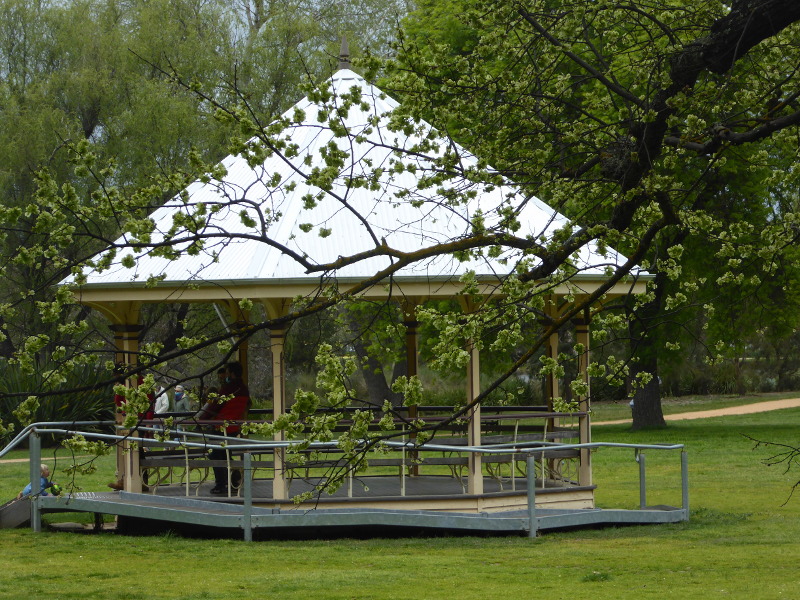
Quite a lot of the structures in and around the Gardens are remodelled or rebuilt – often around 2011, when a lot of work seems to have been done – using the original design as the basis for the new build.
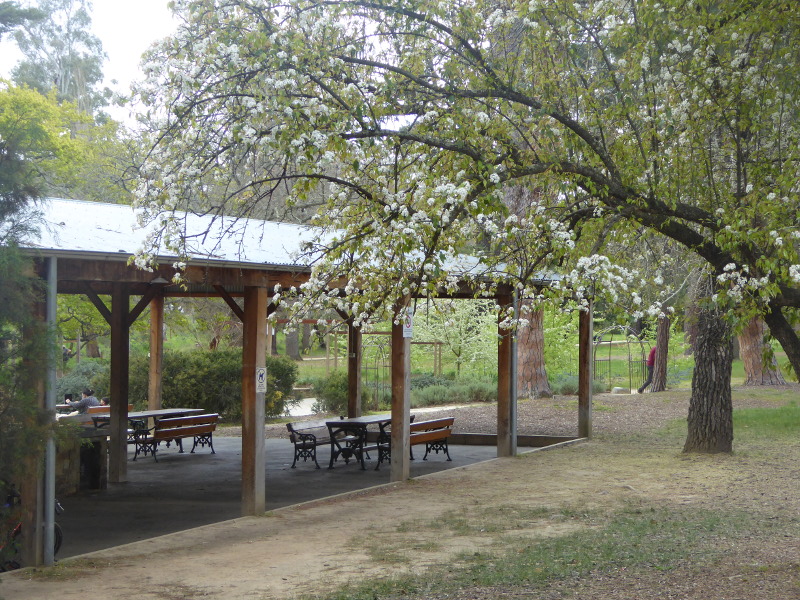
That’s the case for this picnic shelter, based on the original 1898 design.
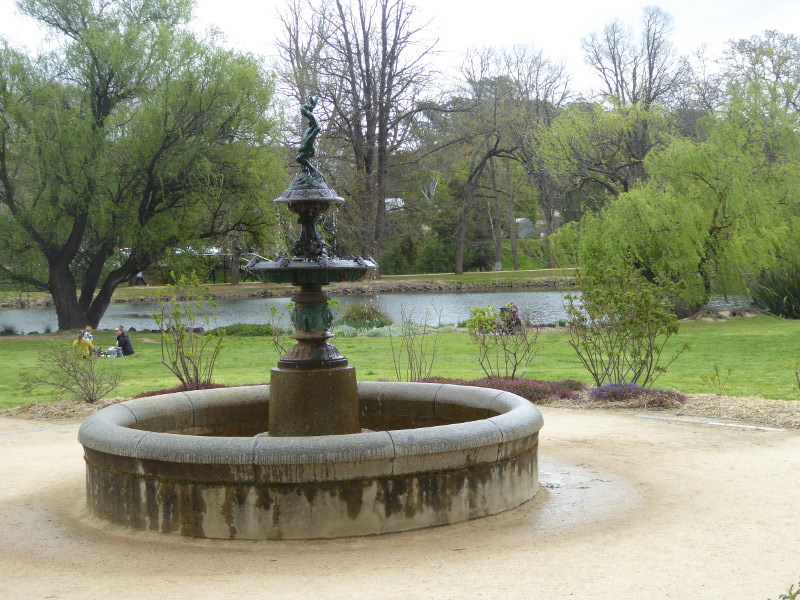
Same goes for the 1880s fountain., beautifully recast in 2011 because the original metal had corroded.
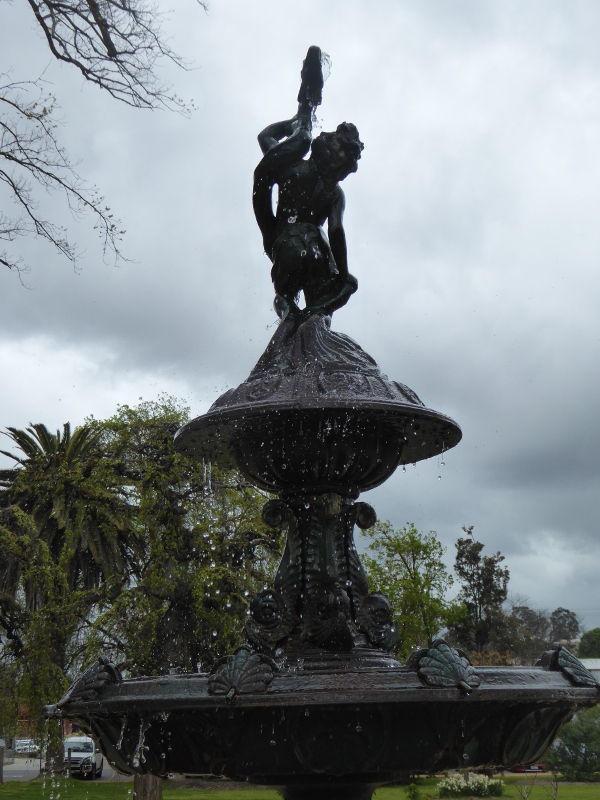
And the 1872 summerhouse, reopened in 2000 after a complete rebuild.
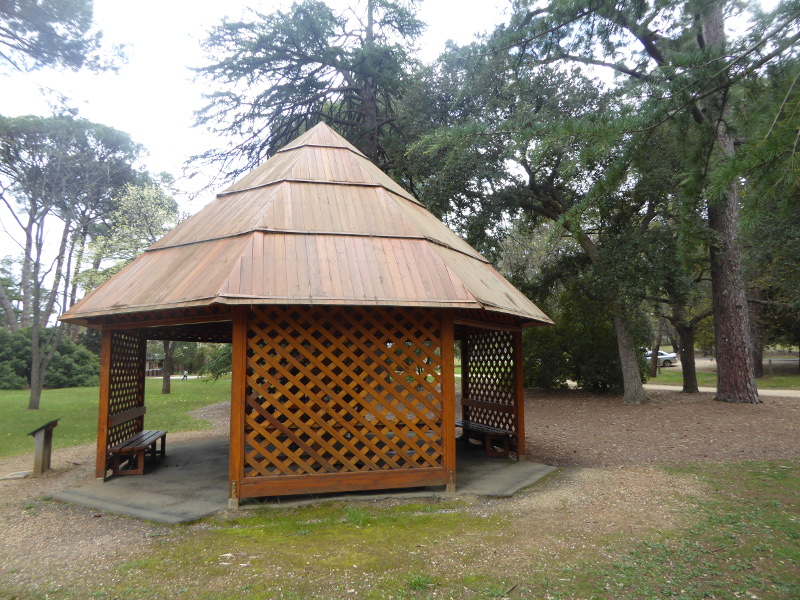
The rotunda in Castlemaine Botanic Gardens was a bit of a mystery. It looks fairly vintage, but with no signage near it (surprising in Gardens with so much good signage), it’s impossible to tell.
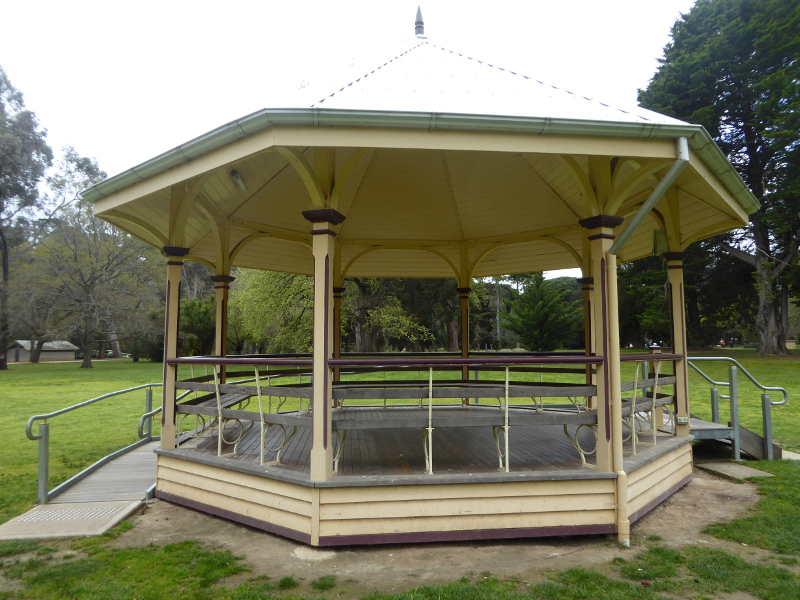
Similarly, this sundial is a beauty, dedicated to a former senator for the area, whose name I was pleased to see, since a street presumably named after him can be seen from our lounge room window.
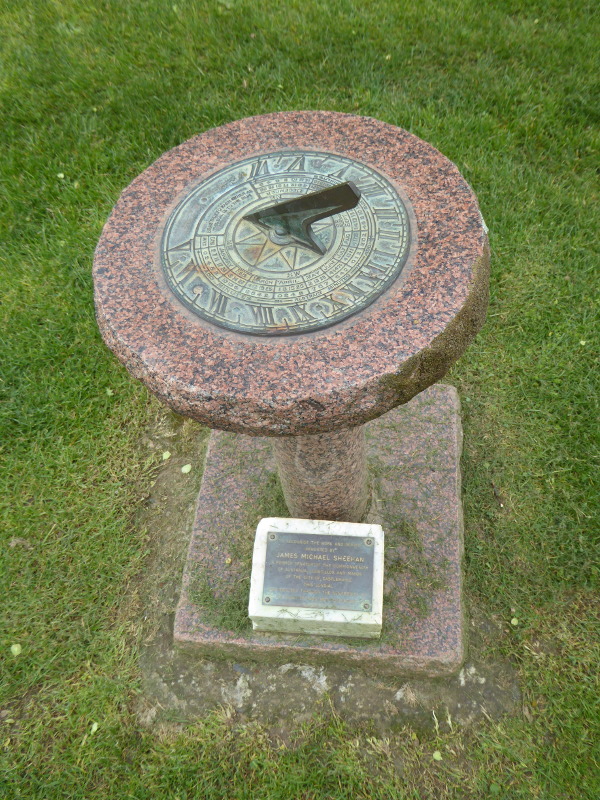
The entrance gates on the town side of the Gardens are attractive enough, but not on the level of, say, Hamilton or Williamstown, and again, no signage to tell us anything about where they were forged or when they were installed. The stone pillars which frame the gates had been originally planned for local Malmsbury bluestone, but I don’t think they ended up using that for Castlemaine?

I was pleased, though, to see that the benches on which I have stretched many a muscle after my Saturday morning runs, do have Castlemaine engraved on their bases, so they were presumably forged in the local foundry. I had to peer down close to see that, though, and I’d be making more of that local connection if I was in charge of information boards round here…
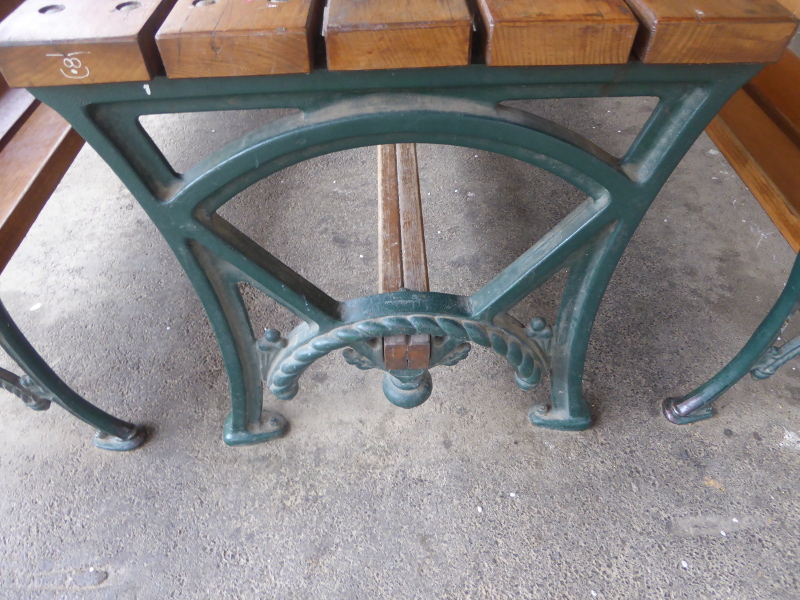
I did like the information board on how the beautiful lake got its name (Joanna was the wife of a 19th century mayor of the town) and it told the interesting story of the prison labour used to dig it (also picked up via my own research on Trove). The old photo on this sign is a bit pock-marked but it’s nice to see the lake as it once was – but when was this picture taken? Any guesses?
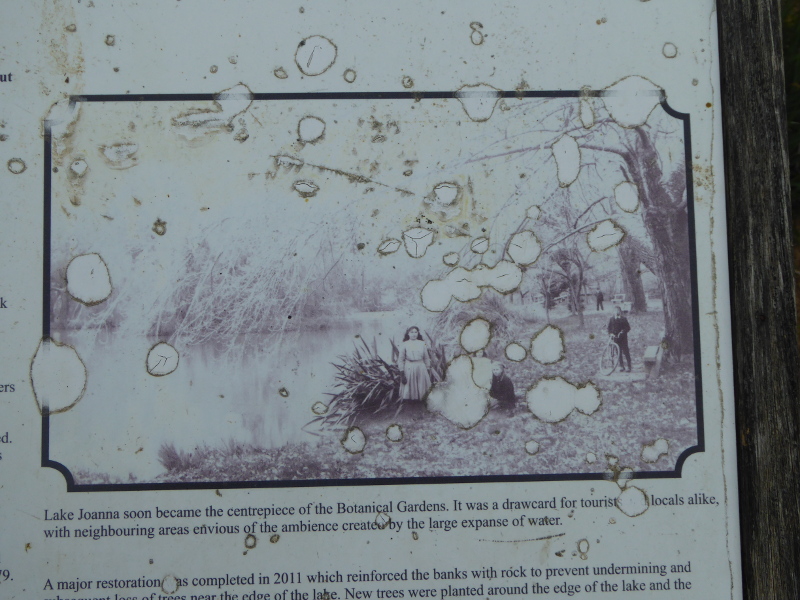
In terms of vintage structures, the 1919 tea rooms are the centrepiece of the Botanic Gardens in Castlemaine. I’m not totally convinced they haven’t also been renovated, and they were being used for a private function on the day I dropped by, so couldn’t mooch around too much.

But here the signage was good, telling the story of the volunteers who provided tea for the picnics and other events held in the Gardens in those roaring 20s and beyond. It’s not clear, apparently, when they stopped functioning as tea rooms, but since 1962 they have also been home to the local highland pipe band. I don’t know when they rehearse, mind you, and I have never heard them, so either the rooms are extremely well insulated, or they are the quietest pipe band ever…
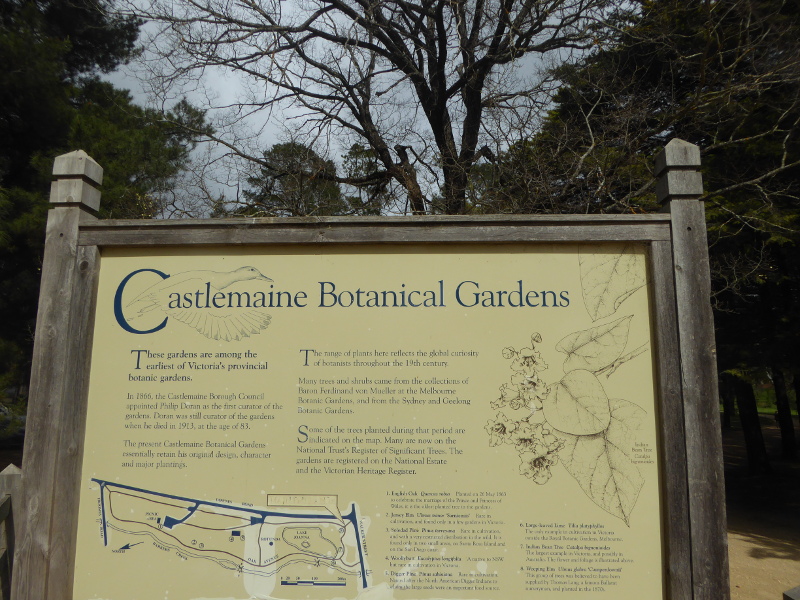
I was pleased to see the original curator, Mr Doran, get a mention on the main information boards by both entrances. He was responsible for most of what we see today in terms of shape and old trees.
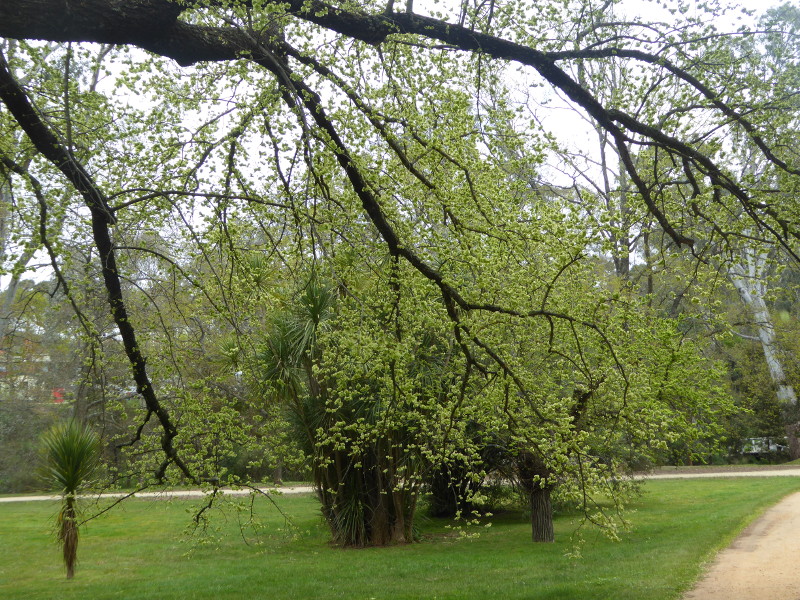
I had no idea during my 100 or so previous visits for my runs that there were so many elms in the Castlemaine Botanic Gardens. Lots of English elms and Dutch elms, which are so abundant in Australian botanic gardens, but virtually wiped out in Europe now. They were not quite in full leaf at the time of my visit, but I know them well, and use them as distance markers on those regular parkruns, so I’m pleased to know now what I am running past.
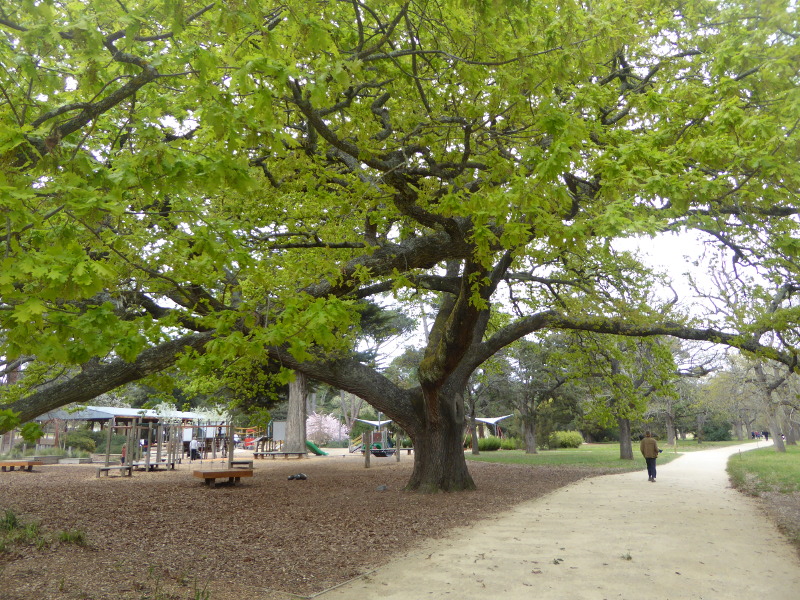
I loved this oak tree, planted in 1863, and now the oldest tree in the gardens, still going strong. It was planted, apparently, for the marriage of the then Prince and Princess of Wales, and looks in fine health. It was swarming with bees, too, on the day I walked past, so it looks like it’ll be here for a while longer yet.
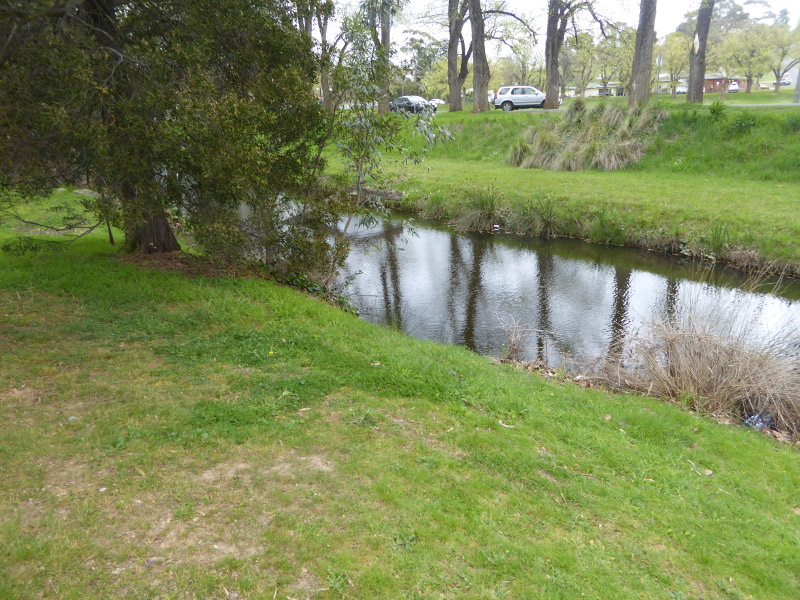
There was no sign of the tree planted by the Duke of Edinburgh in 1867 (unless someone knows different?); it may not have survived, of course. And there were no willows any longer along the banks of the creek.

There are still willows hanging over the lake, though.

And I am very fond of the wisteria arch, which also goes back decades. It was not quite in full bloom for my visit, but I know it well, having to duck under its flowers and leaves three times a week on those Saturday morning runs.
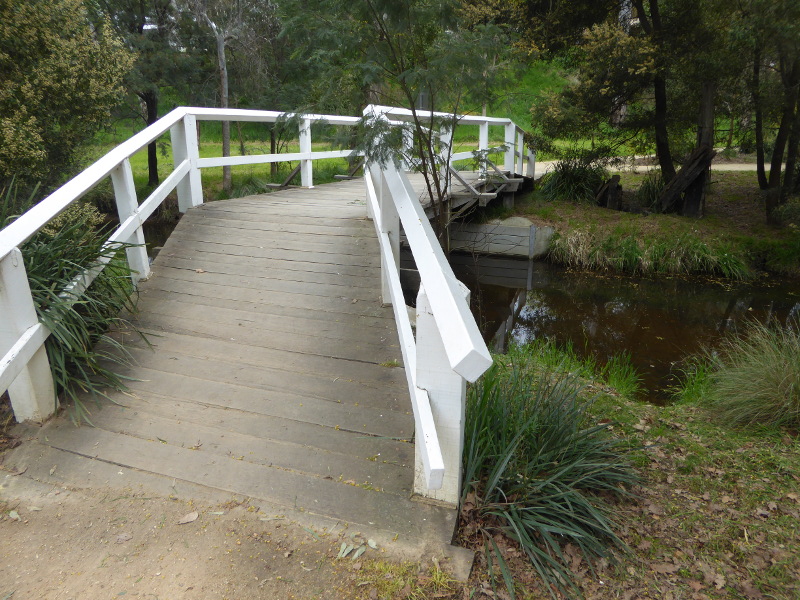
Another of my time markers on those runs is this bridge over the creek. It leads to the grassy and wooded area that was once part of the original gardens reserve leading up to the asylum (now hospital). The frogs were in full voice as I walked past, so spring was well and truly in the air.
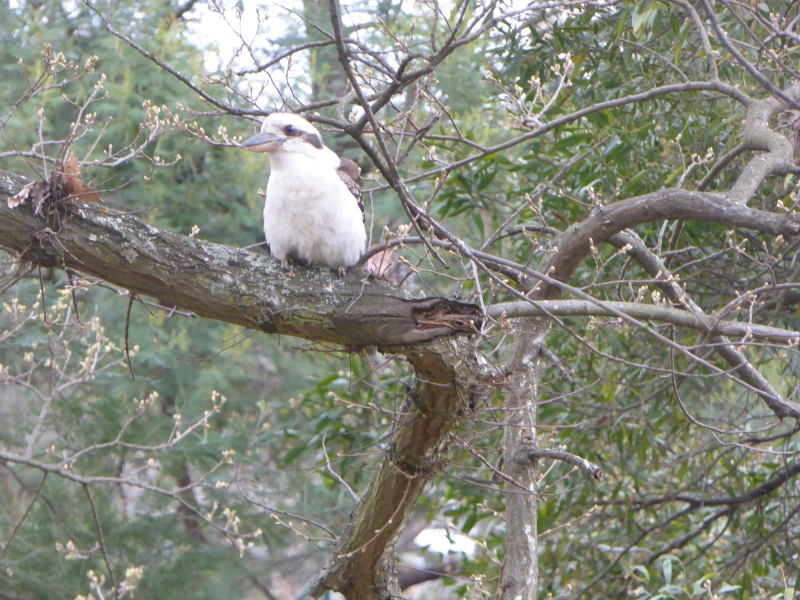
And so ends my tour of botanic gardens in Victoria, at least the vintage ones. I know there are 19th century gardens in Burnley and St Arnaud among others, which I might one day add to Vintage Victoria, but for now I have a few more lighthouses, piers and jetties to visit for the Vintage Victoria project before I branch out and expand my search.
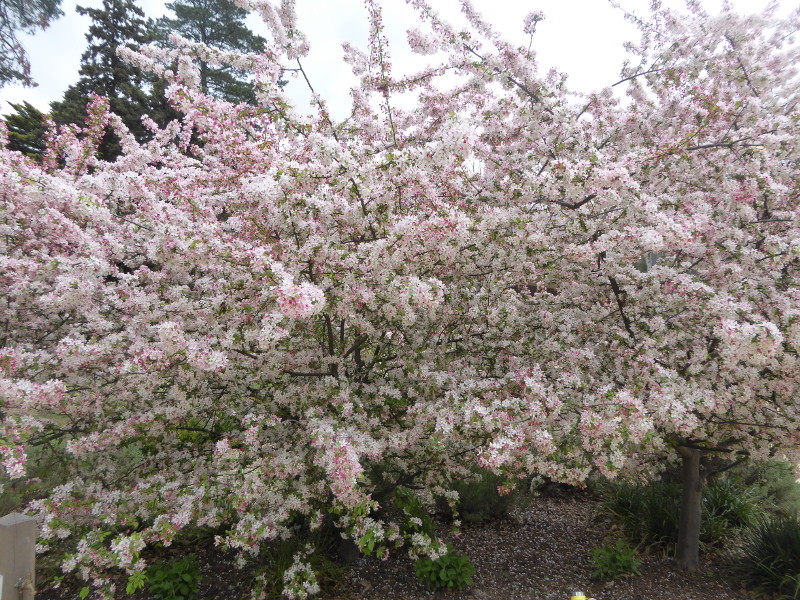
It was nice to finish with my nearest botanic gardens to home, and good to learn some new things about a place I visit so often. Thanks, Castlemaine Botanic Gardens!
Practicalities
There are two sets of toilets in Castlemaine Botanic Gardens.
Lots of places to sit though I’m not sure I’d picnic on the grass, as there are signs up most summers about snakes being seen in the gardens….
The gardens are open every day and accessible at all times..
History and stories
Castlemaine Botanic Gardens may have opened in 1860, but the first story in the Trove press archive dates from seven years later, when the then Duke of Edinburgh toured Victoria. He planted a tree in Castlemaine’s botanic gardens just days after doing the same in Geelong – I wonder how many trees he ‘planted’ in all, though I have to wonder if he got his shoes dirty in doing so, but the press was pretty deferential in those days, so we probably wouldn’t have heard if any mishap did crop up. During the Duke’s subsequent trip to Sydney, he was shot in the back, close to the spine, and was lucky to survive, so there was drama to Royal visits even back then.
In 1877 there were plans for new gates to be built onto Malmsbury blue stone bases; there would also be a fence around the gardens in iron also standing on bluestone. By January 1879, the lake was being dug, with 18 prisoners used for the labour. The creek which now runs along the fringe of the gardens was described in 1880 as running through the botanic gardens, with the ‘Benevolent Asylum’ up on the hill above, presumably where the hospital now stands. There were weeping willows along the banks of the creek.
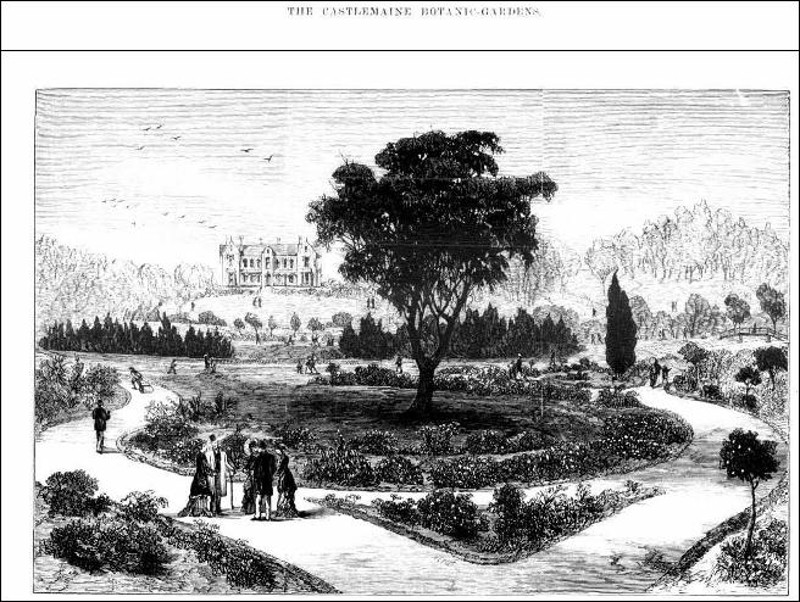
The cultivated part of the original gardens is probably the same as today’s Botanic Gardens area, with the section beyond the creek left as parkland in the 1880s – the creek at that time was described as being full of sludge from the mines and not a pleasant stream.
Two brass bands were engaged for the employees of the Victorian Railways’ annual picnic held in the Botanic Gardens in 1883.
A very brief news item from 1886 was intriguing. A man called Peter Niall, a letter-carrier (the old name for a postie perhaps?), was found to have been hiding letters away in a closet in the Castlemaine Botanical Gardens. I wonder what the story was behind that one: a hoarder? Did he read any of the letters? How was he found out? At his trial it was revealed that in all 96 letters, 20 packets and 13 newspapers had been secreted in the Gardens hideaway. His defence was that he was so drunk on the job, he didn’t know what he was doing. This still doesn’t answer my questions, but he was found guilty, and his employer reprimanded for allowing him to work while drunk.
1889 saw torrential rains which washed away hedges, fences, plants and soil from the gardens. In 1892 there was clearly amusement in the media at the story of a ‘stout old lady’ who fell into the botanic gardens lake while drunk. She was fished out of the 8-foot deep water ‘with great difficulty,’ but was still clutching her beer bottle when she reappeared.
The Combined Orange Picnic in 1906 had lots of sectarian speeches, critical of the power of Catholics in the region. Remembering the violence between schoolkids on the two sides of the sectarian divide in the Bendigo Botanic Gardens in an earlier post, this must have been a massive issue, especially as Ireland moved towards independence. Upwards of 7000 would attend this annual event.
Another picnic in 1908 caught my eye. This brought 1000 people to the gardens from the newly-formed Shop Assistants’ Union in Bendigo (I wonder how many shop assistants are unionised these days in 2021?). The ‘sports’ included different races for women according to their marital status – couldn’t have the Misses mixing with the Missus, can we? And a ‘juvenile walk’, where two of the competitors were toddlers, who apparently caused much amusement (though the journalism of the day failed to tell us what they did that was so funny, so we can only imagine…).
October 1908 saw an organised fight in the Botanical Gardens, with the main assailants even wearing boxing gloves. It seems that two men had had a disagreement on the Saturday night, so arranged to fight it out on the Sunday morning in the gardens. Reports said that in the 2nd round of the contest, onlookers joined in and it became a brawl. 18 people were arrested.
In 1910, the curator Mr Doran received a bag of 50 sovereigns in recognition of 44 years’ work creating and then maintaining the Botanical Gardens at Castlemaine. He turned 80 later that year, and continued in the role until just a month before his death in 1913.
New Year’s Day 1914 saw thousands of visitors picnicking in the Gardens in what one newspaper described as “among the champion days as far as the popularity and pleasure of the gardens were concerned.” As an illustration, the article announced that 50 gallons of ice cream had been consumed by the middle of the day.
Picnics continued through the Great War, but there were also more serious events going on in the Gardens over the years of conflict: the Prime Minister came to Castlemaine and made a speech in the Gardens, responding to comments from the Bendigo Archbishop on Irish independence; there were recruitment drives for more volunteers even as late as 1917, again done inside the Castlemaine Botanic Gardens; and the Gardens’ assistant curator saw action at the front.
Just as peace was about to be announced, there was violence of a different kind in the Botanic Gardens. The local police constable, on 10 November 1918, was on duty in the Gardens when he was attacked by a swarm of bees. The stings were so severe that he needed several days off work, so I don’t suppose he took part in any peace celebrations…
Some years later, a brief news item made it to the Melbourne papers, after a boy dressing up as a wolf cub during a cubs’ picnic was attacked ‘viciously’ by a dog in the Gardens. The costume must have been too realistic, reckoned the report, though apparently the dog was ushered away before it injured the poor little cub. More tragically, in 1968, two teenage boys fell to their death when a platform they had built high up in a pine tree in the Gardens gave way.
The State Festival has been held every two years in Castlemaine since the mid-1970s, and the Botanic Gardens plays host to theatrical and musical events every time, even in 2021 when so much else was cancelled due to Covid.
Some things from the past have now gone: There was a bowling green and pavilion in the gardens in 1894. There were also propagating glass houses at one point. And when the woollen mill and iron foundry right next to the gardens were in full swing, many workers would spend their lunch hours relaxing in the shade before returning to their workplaces.
One thing that is still there, and got a mention in a 1920 article is the wisteria arch. I know it because much as I love wisteria, I do have to duck every time I run through that arch when I take part in the Castlemaine Park Run on a Saturday morning…
What are your experiences at Castlemaine Botanical Gardens?
Has anybody got their own memory to share from a visit to Castlemaine Botanical Gardens, perhaps dating from some decades ago, or just tell us what you like best about the gardens today?
Has anybody seen or heard the Highland Pipe Band recently? And are there any vintage features inside the old tea rooms where the band rehearses and other events often take place?
Other links and writings on the Castlemaine Botanical Gardens
The Bendigo Region website writers visited the gardens almost exactly a year ahead of my visit – their focus was more on the plants than the history but nice entry
Aggregata was a 2013 visitor, also focusing more on trees than anything else, but a bit of history in here, too.
This is from the Castlemaine Garden Club in 2018 after a talk from the then curator.
I like Ruthie Anley’s entry on the Weekend Notes website from 2018. A very personal story of her experiences over the years, including like me doing the weekly ParkRun.
Nice story that the old oak tree was voted (though not sure by whom?) Victorian Tree of the Year in 2021.


I thoroughly enjoyed the article Simon & it brought back many memories for me. I was born in Castlemaine in 1952 & lived there until 1969. I remember having to alight my bike to go through the gardens to the pool, which annoyed me as as I wanted to get to the pool as quickly as I could. Also there was a danger of being chased by a pair of back swans who had made their home on the island, but came ashore hoping to grab any morsels that picnickers left. There was also a kiosk that was managed voluntarily by neighbours of ours. It wasn’t opened often but I remember buying the odd icy pole. I think I caught a glimpse of it in the background of the wisteria photo. Yabbying was also a popular past time with families. Of course the rear of the gardens wasn’t as manicured as it is now. We spent many an hour collecting the pine nuts & pine cones. They were great times & the gardens will always have a special place in my heart.
Thanks for the colourful memories, Gail. Ah so the little building near the wisteria was a kiosk once upon a time? Good to know.